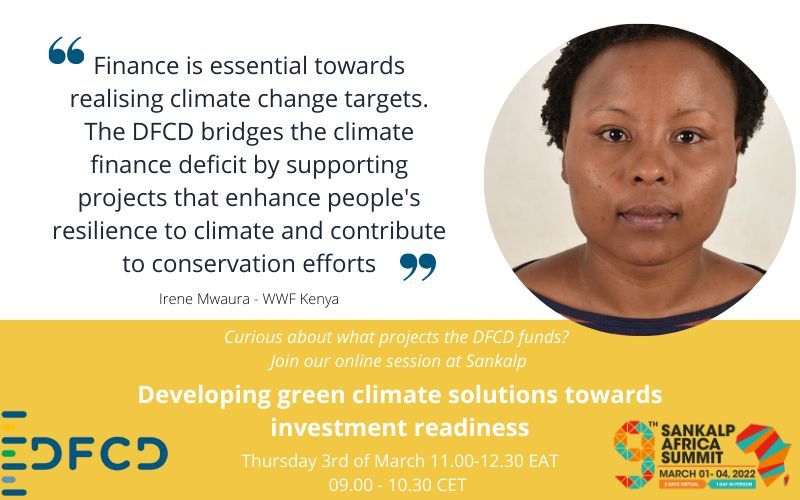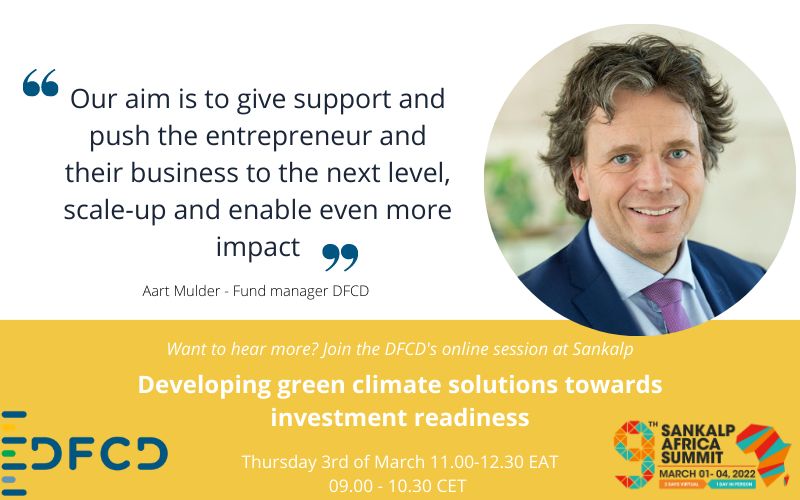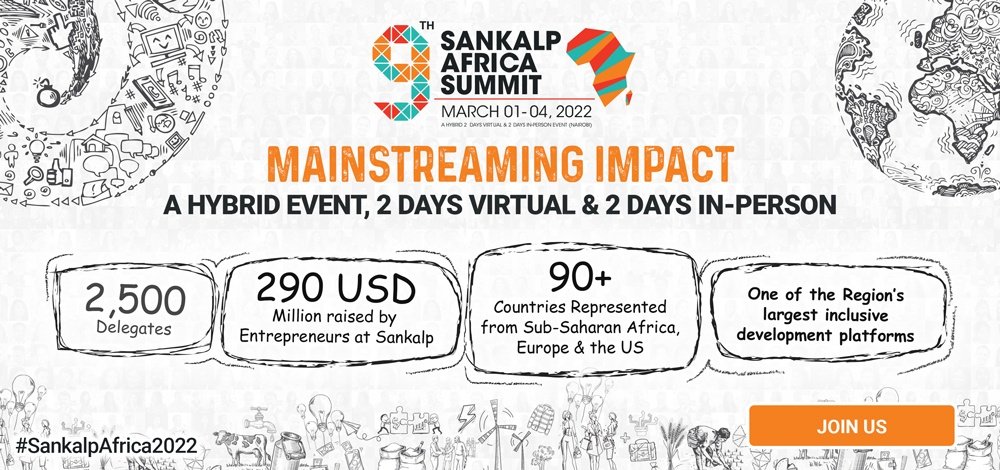Looking back on the Sankalp Forum in Kenya: Q&A
In March 2022, DFCD Africa colleagues organized an event at the Sankalp Africa forum in Nairobi. It was our opportunity to meet the players of the entrepreneurial ecosystem and discuss scalable climate solutions together.

What is the Dutch Fund for Climate and Development?
In 2019, The Dutch Ministry of Foreign Affairs made available €160 million to increase the resilience of businesses, communities, and ecosystems most vulnerable to climate change. The funds continue to be made available through a Public Private Partnership managed by the Dutch Fund for Climate and Development (DFCD), enabling private sector investment in projects aimed at climate adaptation and mitigation in developing countries.
The DFCD is managed by a pioneering consortium of Climate Fund Managers (CFM), WorldWide Fund for Nature Netherlands (WWF-NL) and SNV Netherlands Development Organisation, led by the Dutch Entrepreneurial Development Bank, FMO.

What are the selection criteria for projects?
For large corporate borrowers:
- Are you a green company registered as an incorporated company?
- Do you have assets or net worth of a minimum EUR 5 million?
- Do you have a consistent profitable track record over the past three years?
- Are you able to provide projected financials as evidence of your capacity to service the debt or redeem equity by the maturity date?
- Do you have the capacity to co-invest up to half the project cost in the project implementation stage?
- Are you able to address two of the four key Rio Marker 2 sectors critical to tackling climate change and achieving SDGs? (see below)
- Climate resilient water systems and freshwater ecosystems
- Promoting afforestation and reforestation
- Boosting food security through climate smart agriculture
- Protecting and restoration of ecosystems.
For new and medium companies:
Are you a green company able to compensate for lack of size and track-record by:
- Signing offtake agreements with key off takers (regional, international brand names preferably).
- Bringing on board committed equity investors willing to support the project with capital
- Showcasing evidence of previous experience of management in the sector, as individuals and as a team
- Ability to arrange a Joint Venture (JV) with a larger partner to acquire critical size and operational track record.
- Ability to address at least two of the four key Rio Marker 2 sectors critical to tackling climate change and achieving SDGs
- climate resilient water systems and freshwater ecosystems
- promoting afforestation and reforestation
- boosting food security through climate smart agriculture
- protecting and restoration of ecosystems.
How does the DFCD work?
The DFCD provides grant finance and technical assistance to support the development (origination) of promising business investment ideas to bankable projects with a focus on climate change adaptation, which mobilize external private sector funding at scale. DFCD funding is divided amongst three operating windows, each with a specific focus: the origination facility, the land use facility, and the water facility.
The DFCD focuses on several high impact investment themes including:
- Climate-resilience
- Improving well-being, economic prospects, and livelihoods of vulnerable groups – particularly women and youths
- Enhancing the health of critical ecosystems, from river basins to tropical rainforests, marshland, and mangroves.
Questions raised and answered at Sankalp Nairobi:
1.What type of opportunities does the DFCD see for climate adaptation projects in East Africa?
Most business cases identified in East Africa are Energy (solar, biomass), Water Sanitation & Health (WaSH) and Agriculture-related (coffee, oil seeds, poultry, dairy).
2. Does the fund work with renewable related projects?
The DFCD finances clean and renewable energy projects only if they are directly linked with the main themes (Agriculture-Forestry- Water and Ecosystem protection)
3. You mention the interlinked spheres of DFCD addressing land resilience and water. Why is there no focus on air quality intervention?
Air quality intervention is addressed by the DFCD through support for investments in non-fossil fuels (clean and renewable energy) which have zero to little emission and in the cyclical economy (reduction of market and sanitation waste in landfills).
4. Do carbon offsetting projects align to the mission of climate mitigation?
Yes, carbon offsetting is focused on having carbon emissions produced by some entities or in some areas offset by implementing projects with other entities such that the carbon emissions reduction is equal to or more than the earlier emissions. However, the DFCD’s main appetite is for adaptation projects.
5. How many companies go from screening to stage 1 to stage 2 and end up in stage 3?
On average, 30 percent of all stage 1 prospects make it to stage 2 while less than 10 percent end up in stage 3.
6. What are the main challenges faced along this graduation process? How does the TA help overcome them?
Overly ambitious project concepts not backed by evidence of capacity / competency to implement. Lengthy delays in securing consultants and for those consultants to commence and complete TA helps through the involvement of SNV or WWF technical experts to provide advisory services in specific areas where such is required e.g., feasibility studies, multistakeholder engagement, organic. Certification, preliminary Environmental& Social Safeguards assessments, Gender and Social Inclusion. This helps de-risk the project and make it more attractive to commercial financiers.
7. How do you ensure agricultural projects are vetted well with quality feedback?
The vetting process for all agricultural is the same as for other projects. For the details that we are keen on please see question 8 below.
8. Please share some pointers on what aspects you would like to see highlighted in application forms.
- Ultimate beneficial owners of the applicant business
- If it is an existing entity – track record in its line of business; if greenfield, then the professional and business track records of its sponsors
- Target market and assumed market positioning
- Financial (historical and projected) and non-financial business information (business model, operational)
9. Do blue carbon projects like mangroves restoration and conservation fall under climate solutions fund?
Yes, they do. We encourage such projects to apply if they meet the DFCD criteria.
10. Does DFCD fund innovative insurance projects e.g., index-based insurance working in ASAL markets across HOA and SAHEL regions?
To the extent that the entity promoting the Index-based insurance has market credibility and meets the DFCD criteria, it will be supported.
11. What are green bonds?
A green bond is a type of fixed-income instrument that is specifically earmarked to raise money for climate and environmental projects.
12. What are the possibilities of partnering/synergizing with similar donor-funded projects?
The DFCD is not exclusive and is keen to partner with similar-minded organisation in the Origination stage (grant and technical assistance) and in financing investment implementation.
13. Please share more about the small business facilities fund – what it will look like, for what sectors what instruments / ticket sizes and potential launch dates?
The Small Facilities Fund is still under construction. Details will be made available soon. Aggregated business investments models that serve smaller investments at a landscape level are of interest to the DFCD.
14. What is a minimum penetration level at a landscape scale that makes the project feasible? Do you adopt a cluster project?
See previous question
15. How long does it take to process the grant?
It depends on the preparedness of the applicant with financial and non-financial information and the development of an origination project proposal. However, a well-documented should get approval within three to four months after the initial intake decision by the DFCD to develop an origination project proposal.

